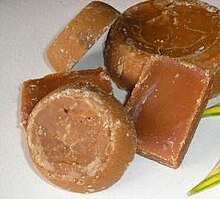
Back Panela Catalan Panela German Πανέλα Greek Panela Spanish پانلا Persian Panela French Panela (alimento) Galician Պանելա Armenian Panela Italian Panela JV
 | |
| Alternative names | Piloncillo, chancaca |
|---|---|
| Region or state | |
| Main ingredients | Whole cane sugar |
| Similar dishes | Jaggery, palm sugar |
| Nutritional value per 100 g (3.5 oz) | |||||
|---|---|---|---|---|---|
| Energy | 1,600 kJ (380 kcal) | ||||
| Sugars | 86.4 g | ||||
0.1 g | |||||
0.2 g | |||||
| |||||
| Other constituents | Quantity | ||||
| Water | 12.3 g | ||||
| Calcium | 79 mg | ||||
| Magnesium | 81 mg | ||||
| Iron | 12 mg | ||||
Source: http://ccbolgroup.com/chancaca.html | |||||
Panela (Spanish pronunciation: [paˈnela]) or rapadura (Portuguese pronunciation: [ʁapaˈduɾɐ]) is an unrefined whole cane sugar, typical of Latin America. It is a solid form of sucrose derived from the boiling and evaporation of sugarcane juice.[1][2] Panela is known by other names in Latin America, such as chancaca in Chile, Bolivia, and Peru, piloncillo in Mexico (where panela refers to a type of cheese, queso panela). Just like brown sugar, two varieties of piloncillo are available; one is lighter (blanco) and one darker (oscuro). Unrefined, it is commonly used in Mexico, where it has been around for at least 500 years. Made from crushed sugar cane, the juice is collected, boiled, and poured into molds, where it hardens into blocks. It is similar to jaggery, which is used in South Asia. Both are considered non-centrifugal cane sugars.[1]
Panela is sold in many forms, including liquid, granulated, and solid blocks, and is used in the canning of foods, as well as in confectionery, soft drinks, baking, and vinegar, beer, and winemaking.
- ^ a b Jaffé, Walter R. (June 2012). "Health Effects of Non-Centrifugal Sugar (NCS): A Review". Sugar Tech. 14 (2): 87–94. doi:10.1007/s12355-012-0145-1. S2CID 255574634.
- ^ Smith, Jennie Erin; Escobar, Federico Rios (26 January 2021). "Colombians Ask: Who Would Dare Patent Panela?". The New York Times. Retrieved 24 March 2021.
© MMXXIII Rich X Search. We shall prevail. All rights reserved. Rich X Search